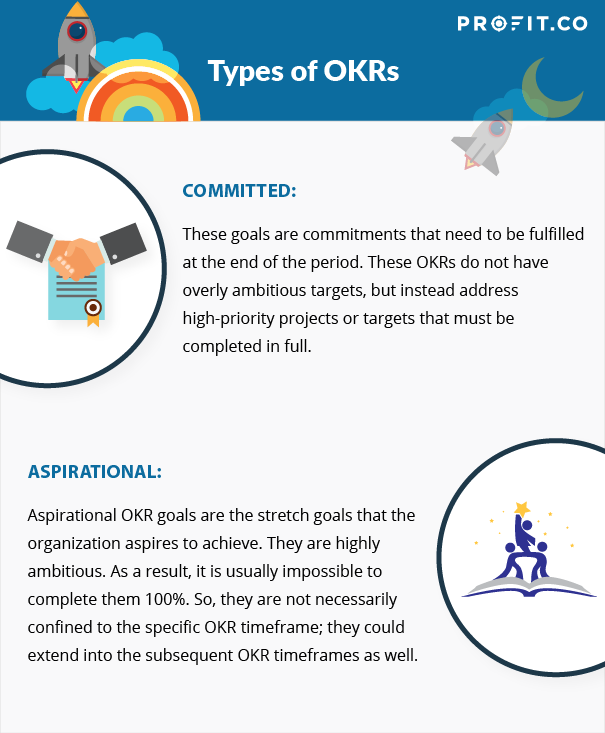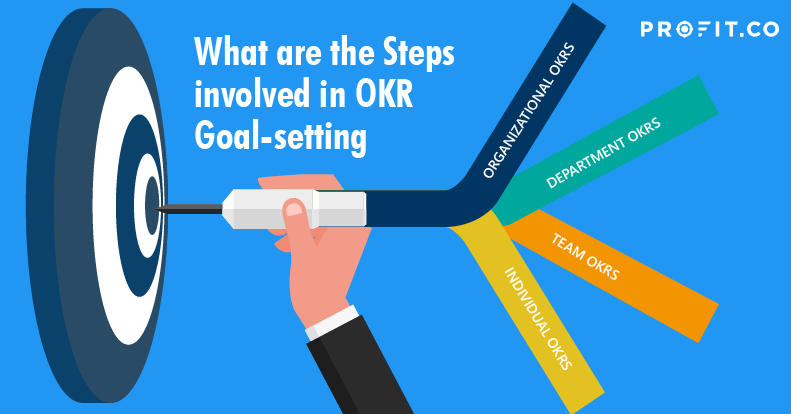While an organization is a complex setup, beneath all those different layers of complexities, the operations of the organization is nothing more than defining an aspiration, which is the organizational goal, and finding the means to achieving it.

Achieving the goals is no simple task. Many goals require every pair of hands in the organization to meet their targets. It is the coordinated collective effort that brings results, growth and achievement of the objectives. However, every individual is different; his or her roles, priorities and capabilities are different. So, there is a need for a system that brings every employee together towards a common purpose and brings the best out of everyone. Objectives and Key Results (OKR) helps you achieve that.
Want to get started with OKRs and performance management on agile and intuitive software today? Start your Profit.co free trial today!
Goal-setting: the process that defines OKR
Objectives and Key Results is a goal setting framework that brings alignment of the employees and makes them work in coordination for a common purpose through ownership of tasks. OKR involves defining an ambitious objective and key results linked to it, which are the actual outcomes that enable the achievement of the objective.
Setting goals is the first step in turning the invisible into the visible.
OKR is time-bound. As a result, employees set OKRs, achieve them within a specified period of time and set newer and more difficult OKRs to challenge their own abilities and overachieve. In this unending cycle of aspiring and achieving, the most important component is the OKR goal setting, which is the process that converts raw ambitions into meaningful deliverables and guides teams and individuals. So, it is vital to know about the steps involved in OKR goal setting.
Steps involved in OKR goal setting
1. Give an orientation for OKR, if needed
There are various frameworks available for goal setting; OKR is just one of them, and is unique in many ways. For instance, it does not tie an individual’s performance to rewards. Instead, OKR has a strong emphasis on collective outcomes. Further, an individual’s goals and targets are not always cascaded down from higher levels of an organization. Instead, they are set by the individual employees themselves. So, the responsibilities of individuals are different in OKR.
If your workforce is not used to such a different tool for setting targets and achieving them, then it is extremely important to communicate what OKR is, how it works and why the organization has adopted this framework. A lack of understanding can lead to errors, mismanagement and lower performance.
2. Select your OKR tool
It is technically possible to implement OKR using spreadsheets and communicating through emails. However, there are several advantages in getting specialized OKR software. The primary reason for getting an OKR software is it can help you instantly share and communicate goals across the organization, which can come in handy when you need to achieve rapid alignment. It automates the collection of data and consolidation of the same into team and organizational achievements, as every individual gets to update every week on the progress made towards individual goals. It results in better data analytics and more actionable insights. OKR software and the OKR framework itself enable instant communication to better execute strategy.
OKR software helps you put performance at various levels into perspective through the visualization of the progress against various goals. Furthermore, dedicated OKR applications help cross-functional teams visualize and better understand the interlinked nature of goals and work with better coordination. Finally, OKR tools offer other benefits such as social recognition. The employees get to publicly recognize the contribution of others, which acts as mutual motivation to push the limits together.
3. Train your staff
When you have chosen the OKR software, you may need to conduct OKR training sessions on how to use the OKR application and how to set and track goals using it. OKR involves employees setting their own goals, updating their progress towards the goals and recognizing other employees. They can also regularly check the progress of other teams as well as the organization towards their goals. So, every employee must be proficient in the software.
4. Choose the timeframe for the completion of OKR goals
While achievement of objectives is an important factor, it is equally crucial to determine when they should be fulfilled. Achieving something in a quarter and achieving the same in a year make a significant difference; the latter could even be considered as failure.
So, the timeframe for OKR goals should be decided. This also determines when the OKRs will be reviewed and the new milestones will be set. Objectives and Key Results, by its very nature, emphasizes on aiming high. So, setting an ambitious but practical timeframe paves way for high performance. It helps to consider the SMART goal model when creating key results. “Time-bound” is one of the five requirements for a well-written goal.
5. Write down OKRs
OKR has two components: Objectives and Key Results. Objectives are where you want to be at the end of the determined period. Key results are the means to achieve them. Objectives are usually qualitative and ambitious. Key results are quantifiable, trackable and measurable outcomes that are aimed at achieving the objectives. They are achievable, albeit with great effort. There are four levels of OKRs. They are:
- Organizational OKRs
- Department OKRs
- Team OKRs
- Individual OKRs
Organizational, or company OKRs, are what the organization wants to achieve at the end of the period. These ambitious objectives are set by the management and communicated to the teams to create a top-down alignment. But the OKR goal setting process takes this non-participatory approach only at this level for the company’s top leadership to set an overall agenda and create a sense of direction for the whole organization to focus on.
Departmental OKRs are usually informed by both team-level OKRs as well as company-level OKRs. While company-level key results cascade down as departmental objectives, teams and sub-departments can roll up their objectives as departmental key results. The department OKR level is a middle layer, and an important component of organization-wide alignment.
Team OKRs are set after discussion with the managers & team leaders of various teams by the management. They are effectively the organizational OKRs broken town into deliverables for various teams at the end of the period. Team leaders propose the team outcomes to achieve them and write down their OKRs. After that, team leaders meet with the members of their respective teams to communicate the agenda and what they need to deliver as a team.
After understanding the team OKRs, individuals split them up into deliverables of their own, negotiate with their managers with regard to the targets they need to achieve, and set their OKR goals accordingly.
Types of OKR goals

There are two types of OKR goals:
- Committed
- Aspirational
Committed OKR goals are commitments that need to be fulfilled at the end of the period. The success or failure of these OKRs are dependent simply on whether they are completed or not by the end of the period. The targets addressed in these OKRs are more realistic for employees to achieve, and they are usually high-priority items that need to be complete by the target date in order for the company to move forward with other targets.
Aspirational OKR goals are the stretch goals that the organization aspires to achieve. They are highly ambitious. As a result, it is impossible to complete them 100%. So, they are not necessarily confined to the specific OKR timeframe; they could extend into the subsequent OKR timeframes as well. These enable the employees to overcome the challenges and overachieve through innovation and out-of-the-box solutions and workarounds, which otherwise would not have come to existence.
6. Build a consensus across the organization
Once the OKR goals are decided at all three levels, the team leaders/managers verify the OKR goals of the individuals and verify their alignment to the team goals and the organizational goals. Any lack of alignment at any level will be identified and corrected quickly. There could be a lack of understanding on how to write good OKR goals.
As a result, there is a risk of employees not setting OKR goals for performance in the correct way. Team leaders and managers can guide them and edit the OKRs. At the end of this OKR goal setting and verification process, everyone will have the consensus over what they will achieve at the individual level, as a team, and as an organization.
This sets the baseline for all the operations in the organization until the end of the OKR timeframe.
Want to learn how Profit.co can help your organization get the most out of OKRs? Book a free demo with our OKR experts today!
Things to avoid in OKR goal setting
While setting OKR goals, it is essential to avoid setting:
- Goals that are too easy to achieve.
- OKRs that have too many key results.
- Objectives that have no deadlines
- Key results that cannot be measured or tracked.
- OKR Goals that are forced on employees.
- Key results that are tasks and not actual outcomes.
- OKRs that are not at least 70% achievable.
- OKR goals that are not in line with the organization’s objectives
Ready to start your OKR Journey for FREE?

